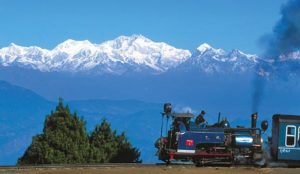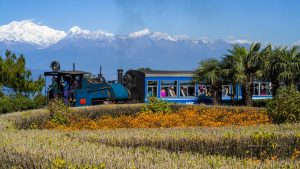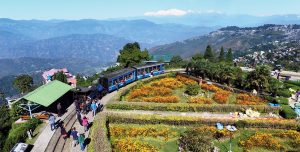Darjeeling
Perched high atop a steep mountainous ridge, Darjeeling lies like a jewel surrounded by the lush tea plantations on nearby hills and by the brilliantly white Himalaya range off in the distance. Before the independence when the temperature is growing and hot weather then British officers came here for relax with their families. This is still true and the city remains a very popular destination for international visitors and vacationing Indians alike. Kanchenjunga, the world’s third-highest peak at 8,598 meters high, is the most prominently visible mountain. In fact, on remarkably clear days Nepal’s Mount Everest can be seen as well. Dense evergreen forests lie around the town, fed by the foggy mountain air that often obscures the surroundings. Darjeeling is certainly known throughout the world as a prominent source of fine teas, as the region produces 7% of India’s tea output, equal to approximately 9,000,000 kg every year. The city, with its forever winding roads and alleys, is home to many historic buildings, many of which are from the period of the British colonial rule. below is given famous tourist places to visit in Darjeeling.
Famous Tourist Places to visit in Darjeeling
 Tiger Hill: This auspicious site is a summit in nearby Ghoom, famous for spectacular sunrise views over the Himalayas. Many visitors in group or solo assemble here in the dark to catch the first golden light of the sun as they crest over the horizon and illuminate the twin peaks of hill Kanchenjunga. Not just an attraction for tourists, the experience of seeing the brilliant pink rays light up the peak is well observed by native travelers alike.
Tiger Hill: This auspicious site is a summit in nearby Ghoom, famous for spectacular sunrise views over the Himalayas. Many visitors in group or solo assemble here in the dark to catch the first golden light of the sun as they crest over the horizon and illuminate the twin peaks of hill Kanchenjunga. Not just an attraction for tourists, the experience of seeing the brilliant pink rays light up the peak is well observed by native travelers alike.
The Batasia Loop: Although originally intended as one of the many over-and-under track loops in the railway line to effectively gain altitude, The loop is the site of a memorial to the Gorkha regiment soldiers those belonged to Indian army and lost their lives for nation. The loop also serves as an impromptu morning market where vendors sprawl their wares directly on the tracks knowing that the trains do not run until later in the day. Local cooks also set up portable kitchens where tasty snacks are pulled fresh off the fire to create an amazing savory breakfast.
Observatory Hill: Although the Bhutia Busty monastery was originally located here, the site currently hosts the temple of Mahakal which is dedicated to a form of Lord Shiva. The site is still a place of great sanctity for the Bhutias and a symphony of bells can be heard chiming as prayers flags by the thousands flap in the gentle, yet constant, mountain breezes.

The Darjeeling Himalayan Railway: Nicknamed the “Toy Train” due to its diminutive size, this small scale train line was built between 1879 and 1881 to serve both local and military purposes. With a length of about 86 km, the rail line climbs from 100 meters at New Jalpaiguri to about 2200 meters at Darjeeling where it provides visitors with a quaint ride through the town and to points beyond.
Ghoom Monastery: Officially known as the YigaChoeling Monastery, this Tibetan style building was built in 1875 by Lama SherabGyatso and is the largest of the three monasteries in Ghoom. As is customary in Buddhist monasteries, the brightly colored interior walls are lined with small chambers containing sacred texts and hundreds of oil lamps burn softly amid the delicately formed butter sculptures. Along the exterior walls, dozens of embossed bronze prayer wheels allow visitors to encircle the building while spinning each wheel they pass to promote an auspicious future.

The Himalayan Mountaineering Institute: Established in November 1954 to encourage mountaineering as an organized sport in India, this organization conducts classes and informational sessions to encourage the interest of mountain climbing as a popular regional sport. The site also contains a museum and a much revered statue of Tenzing Norgay, the guide who accompanied Sir Edmund Hillary to the top of Mount Everest, as well as the site of his interment.
Tibetan Refugee Self Help Center: Established in 1959, this rehabilitation center helps Tibetan refugees in the Darjeeling Himalayan hill region by providing a facility for the production of Tibetan crafts such as carpets, wood and leather work. Tours of the site include live demonstrations of the craftwork in progress as well as a gift shop for the various items.
 +91-9968737942
+91-9968737942 






